Search Results for special
Explore AI generated designs, images, art and prompts by top community artists and designers.

A graphic illustration featuring three stylized icons of document files. The central icon is a rectangle with horizontal lines inside , representing a text document. To the left is a acrobat logo , recognizable by the "pdf" designation , colored in red. To the right is another document icon , labeled "3b , " suggesting a numbered or titled file. The files are slightly overlapping , and positioned against a plain , white background. The style is clean and minimalist , using bold black outlines for the icons. The composition is straightforward , emphasizing clarity and ease of recognition. The lighting is neutral , with no shadows or special effects. The overall impression is one of simple , digital document representation. ,

We want an in-depth picture of an anime cartoon girl , specifically designed with a dreamlike , ethereal aesthetic that emphasizes her innocence and connection to nature. The perspective should be a high-angle , looking down at her from above (POV) , giving the viewer a sense of gentle observation , almost like a bird's eye view , but still close enough to discern fine details of her expression and surroundings. The overall mood should be tranquil and slightly melancholic , rendered with soft , diffused lighting. The girl is positioned in shallow , crystal-clear water , barely covering her ankles , suggesting a serene pool or a calm , pristine stream. The water should be so transparent that the smooth , round pebbles and fine sand at the bottom are clearly visible beneath the surface. Small ripples should gently emanate outwards from her feet , indicating her subtle presence , but without disrupting the overall stillness. The water's surface should reflect the soft , ambient light , creating a delicate , shimmering effect. Her left hand is held open , palm facing upwards , directly towards the viewer. Within the very center of her palm , nestled delicately , is a single , small , pristine white flower , perhaps a lily-of-the-valley or a simple wildflower. The flower should appear almost luminescent , a tiny beacon of purity against her skin. A few delicate drops of water are captured in suspended motion , just beginning to fall from her outstretched hand , creating tiny , sparkling arcs of liquid light that enhance the magical realism of the scene. Her clothing is wet and clings softly to her form , subtly revealing the outline of her body beneath without being overtly explicit. The fabric should appear slightly transparent where it's most saturated with water , particularly around her shoulders and chest. The texture of the wet fabric should be finely detailed , showing the gentle folds and adherence to her skin , emphasizing the natural immersion in her environment. The color of her garment should be a soft , muted white or pale cream , enhancing her ethereal quality. Her long , straight black hair is a defining feature , cascading down her back and shoulders , partially submerged in the shallow water around her. The hair should be rendered with a luxurious , almost liquid sheen , reflecting the ambient light and appearing incredibly soft and lustrous. Individual strands should be discernible , especially where it is wet , clinging together in graceful , flowing sections. The contrast of her dark hair against her pale skin and the light water will be visually striking. The girl's face is exceptionally beautiful and innocent , with large , expressive eyes that are looking directly upwards , engaging with the viewer's high-angle perspective. Her gaze should be wide and slightly wistful , conveying a sense of wonder and perhaps a touch of vulnerability. Her lips are full and subtly colored , perhaps a natural rose or pale peach , parted ever so slightly as if in a soft sigh. Her skin is flawless and luminous , shaded with gentle , soft tones that suggest natural light. The art style should be a high-quality , contemporary anime illustration , prioritizing soft lines and exquisite detail over bold outlines. The rendering should be smooth and painterly , akin to digital watercolor or soft cel-shading , with careful attention to gradients and diffused light sources. The character design should evoke classic shōjo aesthetics but with a grounded , realistic sense of proportion and gentle emotion. The composition should feel balanced and serene. Her body should be slightly curved , or her head tilted , to naturally accommodate the overhead perspective. The water , the flower , and her expression should draw the eye towards her face and the delicate gesture of her hand , making them the undeniable focal points of the illustration. The empty space around her in the shallow water should contribute to the feeling of peace and isolation. The background , beyond the immediate water , should repainted anime. ,

A captivating and dramatic digital painting featuring the silhouette of a witch in an elegant red and dark , ornate , lavish Victorian-style dress , her hat is very special standing with her s outstanding noble Witch's broom near to an elaborately decorated old Temple with floral decorations. The background is a striking contrast of dark blue and bright red , creating a mysterious and romantic mood. The woman , holding a noble lantern , is surrounded by large , vibrant halloween decorations , autumn leaves gently falling around her , emphasizing the elegance of the scene. Soft rays of light break through the darkness , illuminating the contours of her figure and highlighting the surrounding flowers. The overall composition is balanced , with the decorations forming a vibrant foreground against a more muted background. The artwork showcases an abstract style that blends impressionistic elements with bold colors , creating a sense of movement and emotion. The contrast of light adds depth , casts subtle shadows , and enhances the atmosphere of the work. This artwork is ideal for expressing themes of love and intrigue , conveying a sense of calm amidst the chaos of falling leaves , floating fog glowing from sunbeams in the rain and glows the dress of the beauty woman , candlelight giving a mystical scene , raindrops giving magical reflections and the Moon is shimmering a little through the rain ,

A modern , professional workspace with a computer screen displaying legal documents and charts , surrounded by confident business people from various professions (lawyer , director , accountant , HR specialist , doctor , educator). Bright , inviting colors , dynamic composition , focus on collaboration and efficiency. High-resolution , business style. ,

Logo design for an events company named La Mosca , specialized in lights and sound. Modern and minimalist style , with a creative representation of a fly (“mosca”) integrated subtly into the design. Use vibrant neon colors (blue , purple , green) combined with black background to evoke nightlife , party , and electronic music. Clean vector shapes , sharp lines , and futuristic typography for the text La Mosca. Professional , eye-catching , and versatile for both digital and print. ,

Logo design for an events company named La Mosca , specialized in lights and sound. Modern and minimalist style , with a creative representation of a fly (“mosca”) integrated subtly into the design. Use vibrant neon colors (blue , purple , green) combined with black background to evoke nightlife , party , and electronic music. Clean vector shapes , sharp lines , and futuristic typography for the text La Mosca. Professional , eye-catching , and versatile for both digital and print. ,

Kaamraj Range & Wellness Solutions Men’s Wellness & Power Supplements Enhancement & Specialty Oils Hair , Beauty & Liver Care Protein & Nutrition (Akhada Protein Butter) Future Pipeline: HIV , Cancer , Piles , Diabetes , Ortho , Stress & Women’s Wellness Brahmanand Ayurveda Pvt. Ltd. Trusted Ayurvedic Formulations for Strength , Vitality & Holistic Health ✨ Suggestion for background design: Gradient base: Deep maroon → warm golden → herbal green blend Texture: subtle Ayurvedic patterns / mandala motifs / natural leaf texture overlay Accent: gold shimmer lines or glowing aura effect behind the text ,

traditional southern Vietnamese garment. The top part that covers the torso is called the áo ("shirt" in English). It is mostly associated with rural southern Vietnam , especially in the Mekong Delta. Often worn as a top and bottom set , the áo bà ba is typically a long-sleeved , button-down silk shirt with a scooped neck , paired with silk pants. The shirt is long and split at the waist sides , forming two flaps , and customarily features two pockets. ,

traditional southern Vietnamese garment. The top part that covers the torso is called the áo ("shirt" in English). It is mostly associated with rural southern Vietnam , especially in the Mekong Delta. Often worn as a top and bottom set , the áo bà ba is typically a long-sleeved , button-down silk shirt with a scooped neck , paired with silk pants. The shirt is long and split at the waist sides , forming two flaps , and customarily features two pockets. ,

four-panel dress , is a traditional Vietnamese garment , particularly associated with the northern region. It's a flowing , tunic-like dress typically worn with a long skirt , an ancient bodice called yếm , and a sash. While no longer a common sight in daily life , it remains an important part of festivals and cultural events , especially in Northern Vietnam. Key Features and Components: Four Panels: The name "Áo Tứ Thân" literally translates to "four-paneled shirt , " referring to the two front and two back panels that make up the dress's tunic. Tunic: The tunic is typically made from plain , dark fabric (historically , for practicality) , but can also be found in brighter colors for special occasions. Skirt: A long skirt , often black , is worn underneath the tunic. Yếm: The yếm is a traditional bodice , often white or bright pink , worn as an undergarment. Sash: A silk sash is tied around the waist , over the tunic , and dangles down like ribbons. Cultural Significance: Northern Vietnam: The Áo Tứ Thân is most closely associated with the northern region of Vietnam , where it is still seen in festivals and traditional ceremonies. Rural Areas: It's more commonly worn in rural areas than in urban centers , where the simpler Áo Bà Ba is more prevalent. Special Occasions: The Áo Tứ Thân is often worn during festivals like the Lim Festival , which celebrates traditional folk songs. ,

four-panel dress , is a traditional Vietnamese garment , particularly associated with the northern region. It's a flowing , tunic-like dress typically worn with a long skirt , an ancient bodice called yếm , and a sash. While no longer a common sight in daily life , it remains an important part of festivals and cultural events , especially in Northern Vietnam. Key Features and Components: Four Panels: The name "Áo Tứ Thân" literally translates to "four-paneled shirt , " referring to the two front and two back panels that make up the dress's tunic. Tunic: The tunic is typically made from plain , dark fabric (historically , for practicality) , but can also be found in brighter colors for special occasions. Skirt: A long skirt , often black , is worn underneath the tunic. Yếm: The yếm is a traditional bodice , often white or bright pink , worn as an undergarment. Sash: A silk sash is tied around the waist , over the tunic , and dangles down like ribbons. Cultural Significance: Northern Vietnam: The Áo Tứ Thân is most closely associated with the northern region of Vietnam , where it is still seen in festivals and traditional ceremonies. Rural Areas: It's more commonly worn in rural areas than in urban centers , where the simpler Áo Bà Ba is more prevalent. Special Occasions: The Áo Tứ Thân is often worn during festivals like the Lim Festival , which celebrates traditional folk songs. ,

can you help generate posters: Cafe's Name is Corner Beans with Tag line brewed by bro's 1. it's 1st yr anniversary for our coffee shop and we will have a coffee party 2. we have free croissants for the first 10 customers 3. coffee pong with good music. 4. Add the words come sip , sing , and celebrate this special milestone with us! Create a poster that will attract the people to join the anniversary ,

A dark-skinned woman with an athletic build , with muscular arms and especially her legs. She has red eyes and long white hair that reaches below her waist. Due to her Quirk , she has long rabbit ears that are slightly curved at the top , and a small white tail. This gives her an overall resemblance to an albino rabbit. Her hero costume consists of a white sleeveless bodysuit with dark purple trim around the shoulders and waist , a white furry collar , a large yellow crescent moon on her chest , and two thick metal plates on her stomach. She wears purple thigh-high boots to complement her bodysuit , with a large amount of padding around the heel and toe , making her feet resemble those of a rabbit. She also wears a pair of padded white gloves on her hands , with long cuffs and small triangular protrusions on the edges. ,

a giant (muscular but fat white male strongman (special forces) in a tank top covered in tattoos) , colossal hairy bloated pectoral muscles , exaggerated arm muscles , inflated muscle , fills a humvee with his muscle , crammed into the (driver seat of a humvee) hugging a (6 foot tall) man) , immobilized by colossal muscle , trapezius muscles engulf his head , massive deltoid and lateral muscles , short goatee , full length body , soft smile , kind eyes , baseball hat ,

Physical Characteristics: Size & Build: Towering at around 15 feet tall and 40 feet long , Venenosus Rex exhibits a robust , muscular build with bulky , reduced hind legs adapted for powerful knuckle-walking quadrupedal locomotion , inherited from its Ape DNA. Its stance is low and intimidating , allowing swift bursts of speed and stability. Head: The head is a terrifying blend of Tyrannosaurus rex , Giganotosaurus , and Triceratops shapes—a broad , armored skull with a reinforced bony frill and horn-like protrusions from Triceratops , providing natural defense. Its jaw can open up to 90 degrees , snake-like , capable of delivering crushing bites able to shatter bulletproof glass. Skin & Camouflage: Covered in thick , overlapping Scelidosaurus-like osteoderm armor plates along the back and flanks , providing excellent protection against attacks. The skin contains chromatophore cells from cuttlefish DNA , allowing Venenosus Rex to dynamically change skin color , texture , and pattern for camouflage or intimidation. Arms & Claws: Long , powerful arms inspired by Saurophaganax and Ape DNA end in razor-sharp , hooked claws capable of slashing through armored prey and wielding tools for complex hunting strategies. Teeth & Fangs: Teeth are a deadly combination from the Inland Taipan’s retractable fangs , Komodo Dragon’s serrated teeth , and Northern short-tailed shrew’s sharp incisors , allowing it to pierce armor and inject highly toxic saliva into prey. Eyes & Senses: Equipped with specialized cranial cavities housing infrared vision , enabling night hunting and detection of body heat signatures. Its olfactory and auditory senses are exceptionally refined due to Utahraptor and Komodo Dragon ancestry. Unique Abilities: Extreme Environmental Resistance: Thanks to Tardigrade , Opossum , and Mongoose DNA , Venenosus Rex can survive extreme temperatures , radiation , dehydration , starvation , and bacterial infections. Its organs are shielded by trehalose gel , and its DNA is protected by specialized proteins against radiation damage. It can slow its metabolism down to 0.01% of normal , entering a near-hibernative state during harsh conditions. Toxic Saliva & Venom: Its saliva contains potent neurotoxins and anticoagulants , ensuring even minor bites are deadly over time. Combined with its retractable fangs , it can efficiently incapacitate prey or rivals. Camouflage & Stealth: Dynamic skin color and texture changes allow it to blend seamlessly into diverse environments or mimic threatening patterns to intimidate. Intelligence & Pack Hunting: Enhanced Utahraptor DNA grants high cognitive abilities , including planning , problem-solving , and social pack hunting tactics , making it a highly strategic predator. Tool Use: The combination of long , dexterous arms and ape DNA allows it to manipulate objects , set traps , or use environmental tools during hunts. Wide Jaw Opening: The ability to open its jaw at a 90-degree angle allows for impressive bite range and prey handling , intimidating foes with sudden wide gapes. ,

Physical Characteristics: Size & Build: Towering at around 15 feet tall and 40 feet long , Venenosus Rex exhibits a robust , muscular build with bulky , reduced hind legs adapted for powerful knuckle-walking quadrupedal locomotion , inherited from its Ape DNA. Its stance is low and intimidating , allowing swift bursts of speed and stability. Head: The head is a terrifying blend of Tyrannosaurus rex , Giganotosaurus , and Triceratops shapes—a broad , armored skull with a reinforced bony frill and horn-like protrusions from Triceratops , providing natural defense. Its jaw can open up to 90 degrees , snake-like , capable of delivering crushing bites able to shatter bulletproof glass. Skin & Camouflage: Covered in thick , overlapping Scelidosaurus-like osteoderm armor plates along the back and flanks , providing excellent protection against attacks. The skin contains chromatophore cells from cuttlefish DNA , allowing Venenosus Rex to dynamically change skin color , texture , and pattern for camouflage or intimidation. Arms & Claws: Long , powerful arms inspired by Saurophaganax and Ape DNA end in razor-sharp , hooked claws capable of slashing through armored prey and wielding tools for complex hunting strategies. Teeth & Fangs: Teeth are a deadly combination from the Inland Taipan’s retractable fangs , Komodo Dragon’s serrated teeth , and Northern short-tailed shrew’s sharp incisors , allowing it to pierce armor and inject highly toxic saliva into prey. Eyes & Senses: Equipped with specialized cranial cavities housing infrared vision , enabling night hunting and detection of body heat signatures. Its olfactory and auditory senses are exceptionally refined due to Utahraptor and Komodo Dragon ancestry. Unique Abilities: Extreme Environmental Resistance: Thanks to Tardigrade , Opossum , and Mongoose DNA , Venenosus Rex can survive extreme temperatures , radiation , dehydration , starvation , and bacterial infections. Its organs are shielded by trehalose gel , and its DNA is protected by specialized proteins against radiation damage. It can slow its metabolism down to 0.01% of normal , entering a near-hibernative state during harsh conditions. Toxic Saliva & Venom: Its saliva contains potent neurotoxins and anticoagulants , ensuring even minor bites are deadly over time. Combined with its retractable fangs , it can efficiently incapacitate prey or rivals. Camouflage & Stealth: Dynamic skin color and texture changes allow it to blend seamlessly into diverse environments or mimic threatening patterns to intimidate. Intelligence & Pack Hunting: Enhanced Utahraptor DNA grants high cognitive abilities , including planning , problem-solving , and social pack hunting tactics , making it a highly strategic predator. Tool Use: The combination of long , dexterous arms and ape DNA allows it to manipulate objects , set traps , or use environmental tools during hunts. Wide Jaw Opening: The ability to open its jaw at a 90-degree angle allows for impressive bite range and prey handling , intimidating foes with sudden wide gapes. ,
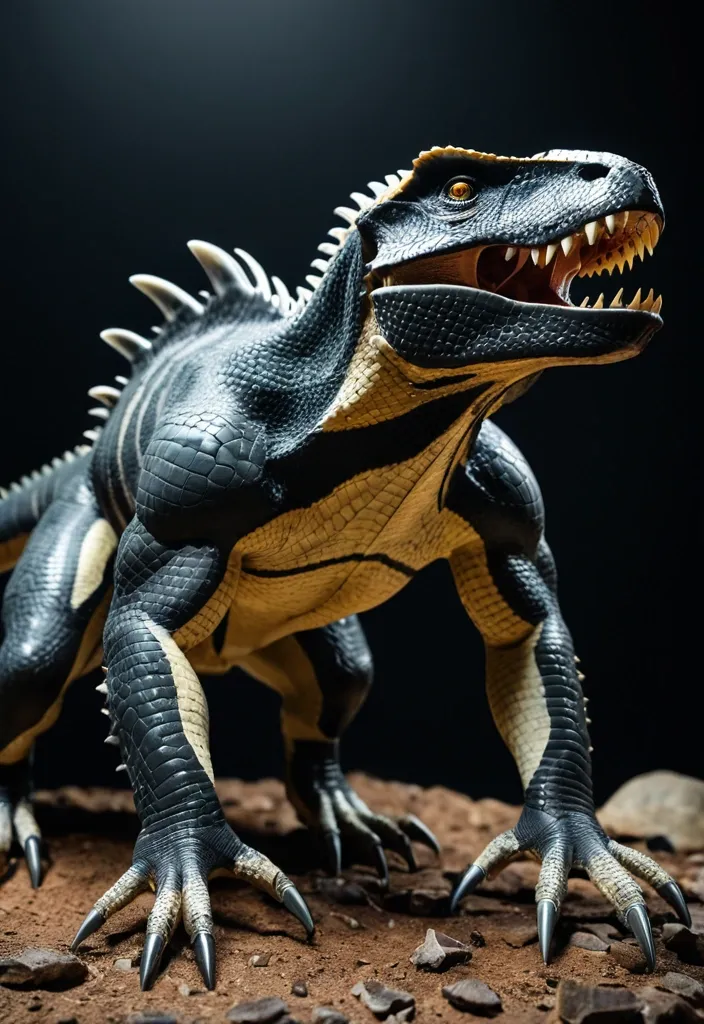
Physical Characteristics: Size & Build: Towering at around 15 feet tall and 40 feet long , Venenosus Rex exhibits a robust , muscular build with bulky , reduced hind legs adapted for powerful knuckle-walking quadrupedal locomotion , inherited from its Ape DNA. Its stance is low and intimidating , allowing swift bursts of speed and stability. Head: The head is a terrifying blend of Tyrannosaurus rex , Giganotosaurus , and Triceratops shapes—a broad , armored skull with a reinforced bony frill and horn-like protrusions from Triceratops , providing natural defense. Its jaw can open up to 90 degrees , snake-like , capable of delivering crushing bites able to shatter bulletproof glass. Skin & Camouflage: Covered in thick , overlapping Scelidosaurus-like osteoderm armor plates along the back and flanks , providing excellent protection against attacks. The skin contains chromatophore cells from cuttlefish DNA , allowing Venenosus Rex to dynamically change skin color , texture , and pattern for camouflage or intimidation. Arms & Claws: Long , powerful arms inspired by Saurophaganax and Ape DNA end in razor-sharp , hooked claws capable of slashing through armored prey and wielding tools for complex hunting strategies. Teeth & Fangs: Teeth are a deadly combination from the Inland Taipan’s retractable fangs , Komodo Dragon’s serrated teeth , and Northern short-tailed shrew’s sharp incisors , allowing it to pierce armor and inject highly toxic saliva into prey. Eyes & Senses: Equipped with specialized cranial cavities housing infrared vision , enabling night hunting and detection of body heat signatures. Its olfactory and auditory senses are exceptionally refined due to Utahraptor and Komodo Dragon ancestry. Unique Abilities: Extreme Environmental Resistance: Thanks to Tardigrade , Opossum , and Mongoose DNA , Venenosus Rex can survive extreme temperatures , radiation , dehydration , starvation , and bacterial infections. Its organs are shielded by trehalose gel , and its DNA is protected by specialized proteins against radiation damage. It can slow its metabolism down to 0.01% of normal , entering a near-hibernative state during harsh conditions. Toxic Saliva & Venom: Its saliva contains potent neurotoxins and anticoagulants , ensuring even minor bites are deadly over time. Combined with its retractable fangs , it can efficiently incapacitate prey or rivals. Camouflage & Stealth: Dynamic skin color and texture changes allow it to blend seamlessly into diverse environments or mimic threatening patterns to intimidate. Intelligence & Pack Hunting: Enhanced Utahraptor DNA grants high cognitive abilities , including planning , problem-solving , and social pack hunting tactics , making it a highly strategic predator. Tool Use: The combination of long , dexterous arms and ape DNA allows it to manipulate objects , set traps , or use environmental tools during hunts. Wide Jaw Opening: The ability to open its jaw at a 90-degree angle allows for impressive bite range and prey handling , intimidating foes with sudden wide gapes. ,

Physical Characteristics: Size & Build: Towering at around 15 feet tall and 40 feet long , Venenosus Rex exhibits a robust , muscular build with bulky , reduced hind legs adapted for powerful knuckle-walking quadrupedal locomotion , inherited from its Ape DNA. Its stance is low and intimidating , allowing swift bursts of speed and stability. Head: The head is a terrifying blend of Tyrannosaurus rex , Giganotosaurus , and Triceratops shapes—a broad , armored skull with a reinforced bony frill and horn-like protrusions from Triceratops , providing natural defense. Its jaw can open up to 90 degrees , snake-like , capable of delivering crushing bites able to shatter bulletproof glass. Skin & Camouflage: Covered in thick , overlapping Scelidosaurus-like osteoderm armor plates along the back and flanks , providing excellent protection against attacks. The skin contains chromatophore cells from cuttlefish DNA , allowing Venenosus Rex to dynamically change skin color , texture , and pattern for camouflage or intimidation. Arms & Claws: Long , powerful arms inspired by Saurophaganax and Ape DNA end in razor-sharp , hooked claws capable of slashing through armored prey and wielding tools for complex hunting strategies. Teeth & Fangs: Teeth are a deadly combination from the Inland Taipan’s retractable fangs , Komodo Dragon’s serrated teeth , and Northern short-tailed shrew’s sharp incisors , allowing it to pierce armor and inject highly toxic saliva into prey. Eyes & Senses: Equipped with specialized cranial cavities housing infrared vision , enabling night hunting and detection of body heat signatures. Its olfactory and auditory senses are exceptionally refined due to Utahraptor and Komodo Dragon ancestry. Unique Abilities: Extreme Environmental Resistance: Thanks to Tardigrade , Opossum , and Mongoose DNA , Venenosus Rex can survive extreme temperatures , radiation , dehydration , starvation , and bacterial infections. Its organs are shielded by trehalose gel , and its DNA is protected by specialized proteins against radiation damage. It can slow its metabolism down to 0.01% of normal , entering a near-hibernative state during harsh conditions. Toxic Saliva & Venom: Its saliva contains potent neurotoxins and anticoagulants , ensuring even minor bites are deadly over time. Combined with its retractable fangs , it can efficiently incapacitate prey or rivals. Camouflage & Stealth: Dynamic skin color and texture changes allow it to blend seamlessly into diverse environments or mimic threatening patterns to intimidate. Intelligence & Pack Hunting: Enhanced Utahraptor DNA grants high cognitive abilities , including planning , problem-solving , and social pack hunting tactics , making it a highly strategic predator. Tool Use: The combination of long , dexterous arms and ape DNA allows it to manipulate objects , set traps , or use environmental tools during hunts. Wide Jaw Opening: The ability to open its jaw at a 90-degree angle allows for impressive bite range and prey handling , intimidating foes with sudden wide gapes. ,
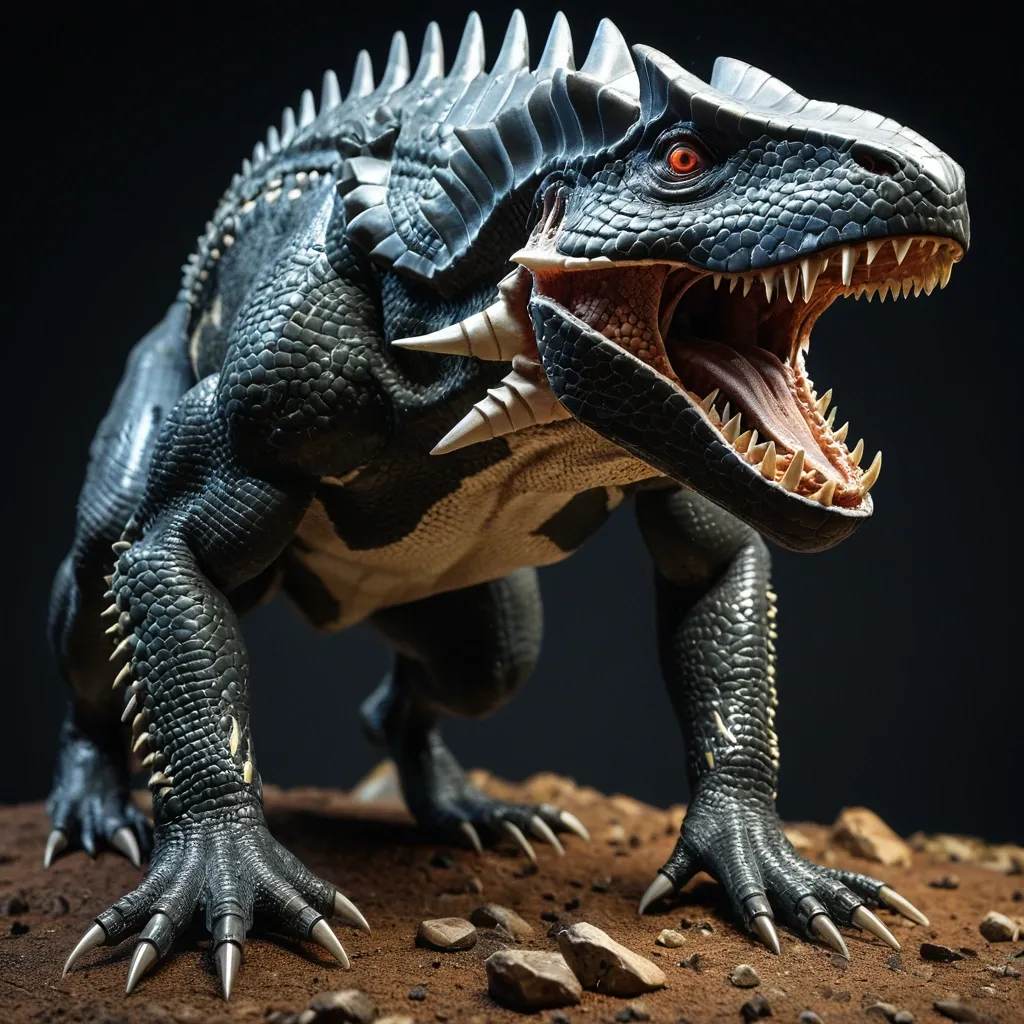
Physical Characteristics: Size & Build: Towering at around 15 feet tall and 40 feet long , Venenosus Rex exhibits a robust , muscular build with bulky , reduced hind legs adapted for powerful knuckle-walking quadrupedal locomotion , inherited from its Ape DNA. Its stance is low and intimidating , allowing swift bursts of speed and stability. Head: The head is a terrifying blend of Tyrannosaurus rex , Giganotosaurus , and Triceratops shapes—a broad , armored skull with a reinforced bony frill and horn-like protrusions from Triceratops , providing natural defense. Its jaw can open up to 90 degrees , snake-like , capable of delivering crushing bites able to shatter bulletproof glass. Skin & Camouflage: Covered in thick , overlapping Scelidosaurus-like osteoderm armor plates along the back and flanks , providing excellent protection against attacks. The skin contains chromatophore cells from cuttlefish DNA , allowing Venenosus Rex to dynamically change skin color , texture , and pattern for camouflage or intimidation. Arms & Claws: Long , powerful arms inspired by Saurophaganax and Ape DNA end in razor-sharp , hooked claws capable of slashing through armored prey and wielding tools for complex hunting strategies. Teeth & Fangs: Teeth are a deadly combination from the Inland Taipan’s retractable fangs , Komodo Dragon’s serrated teeth , and Northern short-tailed shrew’s sharp incisors , allowing it to pierce armor and inject highly toxic saliva into prey. Eyes & Senses: Equipped with specialized cranial cavities housing infrared vision , enabling night hunting and detection of body heat signatures. Its olfactory and auditory senses are exceptionally refined due to Utahraptor and Komodo Dragon ancestry. Unique Abilities: Extreme Environmental Resistance: Thanks to Tardigrade , Opossum , and Mongoose DNA , Venenosus Rex can survive extreme temperatures , radiation , dehydration , starvation , and bacterial infections. Its organs are shielded by trehalose gel , and its DNA is protected by specialized proteins against radiation damage. It can slow its metabolism down to 0.01% of normal , entering a near-hibernative state during harsh conditions. Toxic Saliva & Venom: Its saliva contains potent neurotoxins and anticoagulants , ensuring even minor bites are deadly over time. Combined with its retractable fangs , it can efficiently incapacitate prey or rivals. Camouflage & Stealth: Dynamic skin color and texture changes allow it to blend seamlessly into diverse environments or mimic threatening patterns to intimidate. Intelligence & Pack Hunting: Enhanced Utahraptor DNA grants high cognitive abilities , including planning , problem-solving , and social pack hunting tactics , making it a highly strategic predator. Tool Use: The combination of long , dexterous arms and ape DNA allows it to manipulate objects , set traps , or use environmental tools during hunts. Wide Jaw Opening: The ability to open its jaw at a 90-degree angle allows for impressive bite range and prey handling , intimidating foes with sudden wide gapes. ,
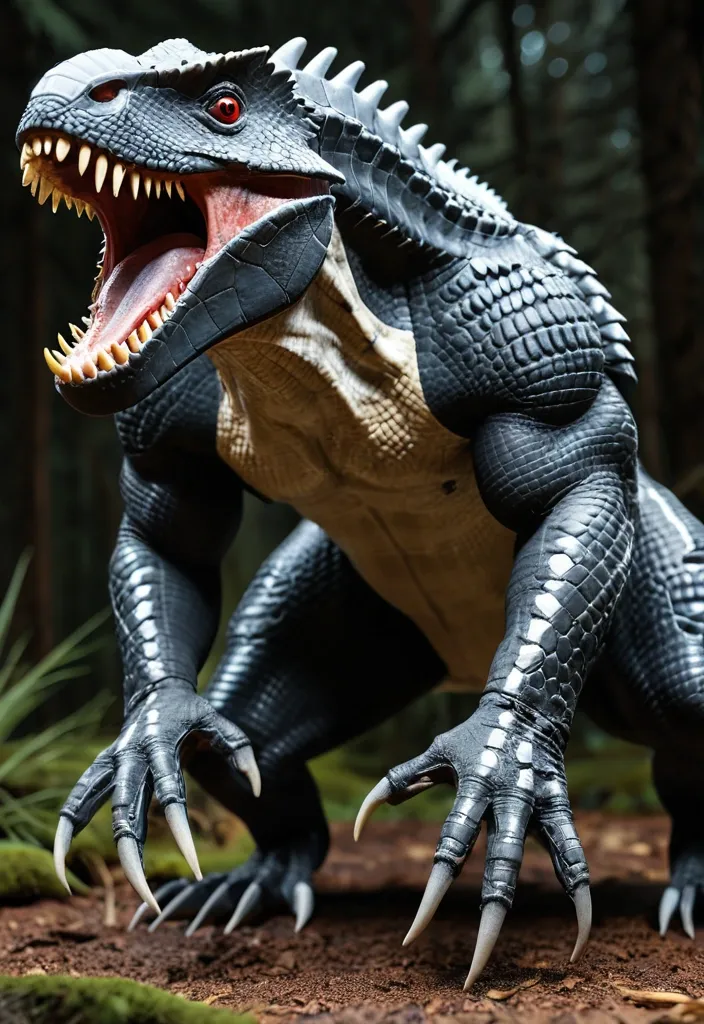
Physical Characteristics: Size & Build: Towering at around 15 feet tall and 40 feet long , Venenosus Rex exhibits a robust , muscular build with bulky , reduced hind legs adapted for powerful knuckle-walking quadrupedal locomotion , inherited from its Ape DNA. Its stance is low and intimidating , allowing swift bursts of speed and stability. Head: The head is a terrifying blend of Tyrannosaurus rex , Giganotosaurus , and Triceratops shapes—a broad , armored skull with a reinforced bony frill and horn-like protrusions from Triceratops , providing natural defense. Its jaw can open up to 90 degrees , snake-like , capable of delivering crushing bites able to shatter bulletproof glass. Skin & Camouflage: Covered in thick , overlapping Scelidosaurus-like osteoderm armor plates along the back and flanks , providing excellent protection against attacks. The skin contains chromatophore cells from cuttlefish DNA , allowing Venenosus Rex to dynamically change skin color , texture , and pattern for camouflage or intimidation. Arms & Claws: Long , powerful arms inspired by Saurophaganax and Ape DNA end in razor-sharp , hooked claws capable of slashing through armored prey and wielding tools for complex hunting strategies. Teeth & Fangs: Teeth are a deadly combination from the Inland Taipan’s retractable fangs , Komodo Dragon’s serrated teeth , and Northern short-tailed shrew’s sharp incisors , allowing it to pierce armor and inject highly toxic saliva into prey. Eyes & Senses: Equipped with specialized cranial cavities housing infrared vision , enabling night hunting and detection of body heat signatures. Its olfactory and auditory senses are exceptionally refined due to Utahraptor and Komodo Dragon ancestry. Unique Abilities: Extreme Environmental Resistance: Thanks to Tardigrade , Opossum , and Mongoose DNA , Venenosus Rex can survive extreme temperatures , radiation , dehydration , starvation , and bacterial infections. Its organs are shielded by trehalose gel , and its DNA is protected by specialized proteins against radiation damage. It can slow its metabolism down to 0.01% of normal , entering a near-hibernative state during harsh conditions. Toxic Saliva & Venom: Its saliva contains potent neurotoxins and anticoagulants , ensuring even minor bites are deadly over time. Combined with its retractable fangs , it can efficiently incapacitate prey or rivals. Camouflage & Stealth: Dynamic skin color and texture changes allow it to blend seamlessly into diverse environments or mimic threatening patterns to intimidate. Intelligence & Pack Hunting: Enhanced Utahraptor DNA grants high cognitive abilities , including planning , problem-solving , and social pack hunting tactics , making it a highly strategic predator. Tool Use: The combination of long , dexterous arms and ape DNA allows it to manipulate objects , set traps , or use environmental tools during hunts. Wide Jaw Opening: The ability to open its jaw at a 90-degree angle allows for impressive bite range and prey handling , intimidating foes with sudden wide gapes. ,

Physical Characteristics: Size & Build: Towering at around 15 feet tall and 40 feet long , Venenosus Rex exhibits a robust , muscular build with bulky , reduced hind legs adapted for powerful knuckle-walking quadrupedal locomotion , inherited from its Ape DNA. Its stance is low and intimidating , allowing swift bursts of speed and stability. Head: The head is a terrifying blend of Tyrannosaurus rex , Giganotosaurus , and Triceratops shapes—a broad , armored skull with a reinforced bony frill and horn-like protrusions from Triceratops , providing natural defense. Its jaw can open up to 90 degrees , snake-like , capable of delivering crushing bites able to shatter bulletproof glass. Skin & Camouflage: Covered in thick , overlapping Scelidosaurus-like osteoderm armor plates along the back and flanks , providing excellent protection against attacks. The skin contains chromatophore cells from cuttlefish DNA , allowing Venenosus Rex to dynamically change skin color , texture , and pattern for camouflage or intimidation. Arms & Claws: Long , powerful arms inspired by Saurophaganax and Ape DNA end in razor-sharp , hooked claws capable of slashing through armored prey and wielding tools for complex hunting strategies. Teeth & Fangs: Teeth are a deadly combination from the Inland Taipan’s retractable fangs , Komodo Dragon’s serrated teeth , and Northern short-tailed shrew’s sharp incisors , allowing it to pierce armor and inject highly toxic saliva into prey. Eyes & Senses: Equipped with specialized cranial cavities housing infrared vision , enabling night hunting and detection of body heat signatures. Its olfactory and auditory senses are exceptionally refined due to Utahraptor and Komodo Dragon ancestry. Unique Abilities: Extreme Environmental Resistance: Thanks to Tardigrade , Opossum , and Mongoose DNA , Venenosus Rex can survive extreme temperatures , radiation , dehydration , starvation , and bacterial infections. Its organs are shielded by trehalose gel , and its DNA is protected by specialized proteins against radiation damage. It can slow its metabolism down to 0.01% of normal , entering a near-hibernative state during harsh conditions. Toxic Saliva & Venom: Its saliva contains potent neurotoxins and anticoagulants , ensuring even minor bites are deadly over time. Combined with its retractable fangs , it can efficiently incapacitate prey or rivals. Camouflage & Stealth: Dynamic skin color and texture changes allow it to blend seamlessly into diverse environments or mimic threatening patterns to intimidate. Intelligence & Pack Hunting: Enhanced Utahraptor DNA grants high cognitive abilities , including planning , problem-solving , and social pack hunting tactics , making it a highly strategic predator. Tool Use: The combination of long , dexterous arms and ape DNA allows it to manipulate objects , set traps , or use environmental tools during hunts. Wide Jaw Opening: The ability to open its jaw at a 90-degree angle allows for impressive bite range and prey handling , intimidating foes with sudden wide gapes. ,
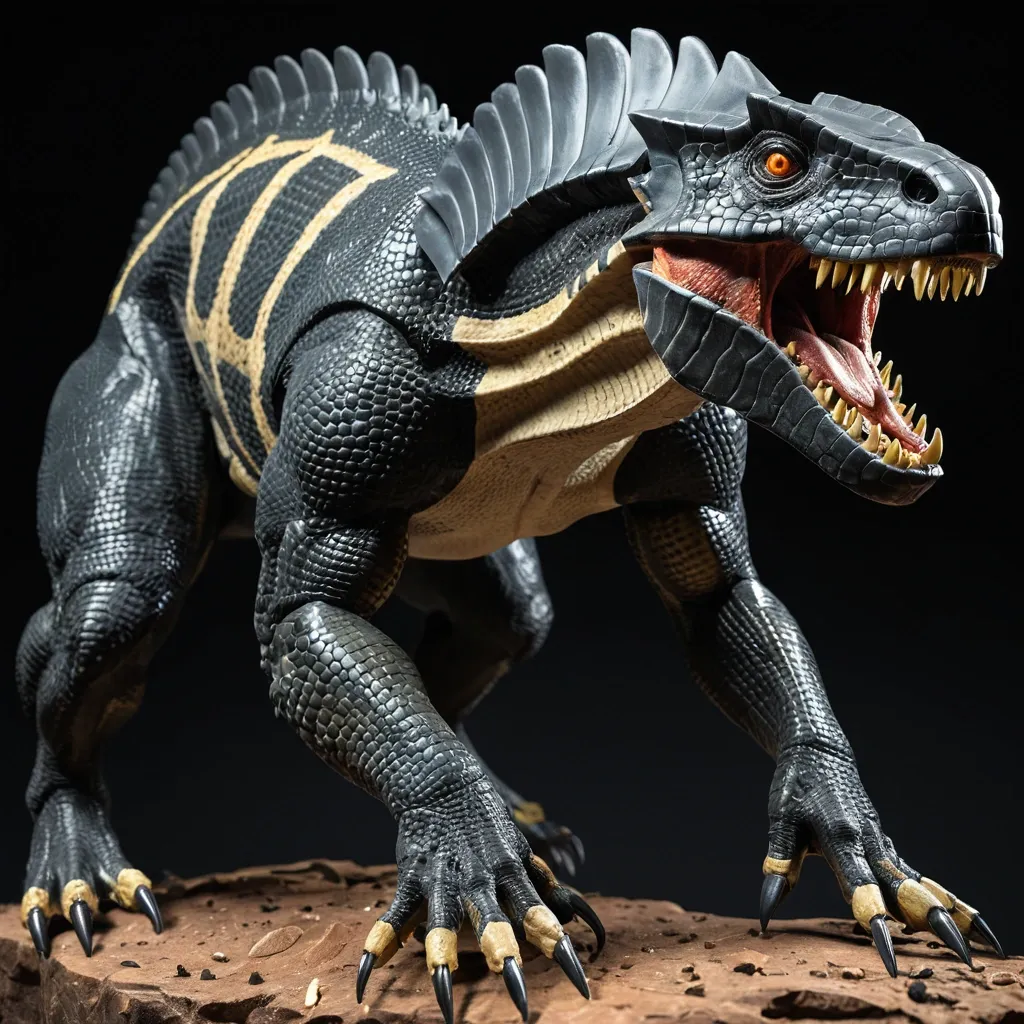
Physical Characteristics: Size & Build: Towering at around 15 feet tall and 40 feet long , Venenosus Rex exhibits a robust , muscular build with bulky , reduced hind legs adapted for powerful knuckle-walking quadrupedal locomotion , inherited from its Ape DNA. Its stance is low and intimidating , allowing swift bursts of speed and stability. Head: The head is a terrifying blend of Tyrannosaurus rex , Giganotosaurus , and Triceratops shapes—a broad , armored skull with a reinforced bony frill and horn-like protrusions from Triceratops , providing natural defense. Its jaw can open up to 90 degrees , snake-like , capable of delivering crushing bites able to shatter bulletproof glass. Skin & Camouflage: Covered in thick , overlapping Scelidosaurus-like osteoderm armor plates along the back and flanks , providing excellent protection against attacks. The skin contains chromatophore cells from cuttlefish DNA , allowing Venenosus Rex to dynamically change skin color , texture , and pattern for camouflage or intimidation. Arms & Claws: Long , powerful arms inspired by Saurophaganax and Ape DNA end in razor-sharp , hooked claws capable of slashing through armored prey and wielding tools for complex hunting strategies. Teeth & Fangs: Teeth are a deadly combination from the Inland Taipan’s retractable fangs , Komodo Dragon’s serrated teeth , and Northern short-tailed shrew’s sharp incisors , allowing it to pierce armor and inject highly toxic saliva into prey. Eyes & Senses: Equipped with specialized cranial cavities housing infrared vision , enabling night hunting and detection of body heat signatures. Its olfactory and auditory senses are exceptionally refined due to Utahraptor and Komodo Dragon ancestry. Unique Abilities: Extreme Environmental Resistance: Thanks to Tardigrade , Opossum , and Mongoose DNA , Venenosus Rex can survive extreme temperatures , radiation , dehydration , starvation , and bacterial infections. Its organs are shielded by trehalose gel , and its DNA is protected by specialized proteins against radiation damage. It can slow its metabolism down to 0.01% of normal , entering a near-hibernative state during harsh conditions. Toxic Saliva & Venom: Its saliva contains potent neurotoxins and anticoagulants , ensuring even minor bites are deadly over time. Combined with its retractable fangs , it can efficiently incapacitate prey or rivals. Camouflage & Stealth: Dynamic skin color and texture changes allow it to blend seamlessly into diverse environments or mimic threatening patterns to intimidate. Intelligence & Pack Hunting: Enhanced Utahraptor DNA grants high cognitive abilities , including planning , problem-solving , and social pack hunting tactics , making it a highly strategic predator. Tool Use: The combination of long , dexterous arms and ape DNA allows it to manipulate objects , set traps , or use environmental tools during hunts. Wide Jaw Opening: The ability to open its jaw at a 90-degree angle allows for impressive bite range and prey handling , intimidating foes with sudden wide gapes. ,

> "Logo design for 'MikhailychAuto' , a company specializing in importing cars from Japan. The mascot is a strong , confident Russian bear wearing a traditional red Slavic embroidered shirt (vyshyvanka). The bear stands proudly with crossed arms , conveying trust and reliability. Behind the bear , include subtle elements like a Japanese flag or stylized Japanese car silhouette to reflect the business focus. Use a circular badge layout with bold Cyrillic text: 'МИХАЛЫЧАВТО' and subtitle 'АВТО ИЗ ЯПОНИИ'. Color scheme: deep reds , warm browns , with accents of white or gold. Style: vintage , bold , clean , suitable for branding and print." ,

> "Logo design for 'MikhailychAuto' , a company specializing in importing cars from Japan. The mascot is a strong , confident Russian bear wearing a traditional red Slavic embroidered shirt (vyshyvanka). The bear stands proudly with crossed arms , conveying trust and reliability. Behind the bear , include subtle elements like a Japanese flag or stylized Japanese car silhouette to reflect the business focus. Use a circular badge layout with bold Cyrillic text: 'МИХАЛЫЧАВТО' and subtitle 'АВТО ИЗ ЯПОНИИ'. Color scheme: deep reds , warm browns , with accents of white or gold. Style: vintage , bold , clean , suitable for branding and print." ,
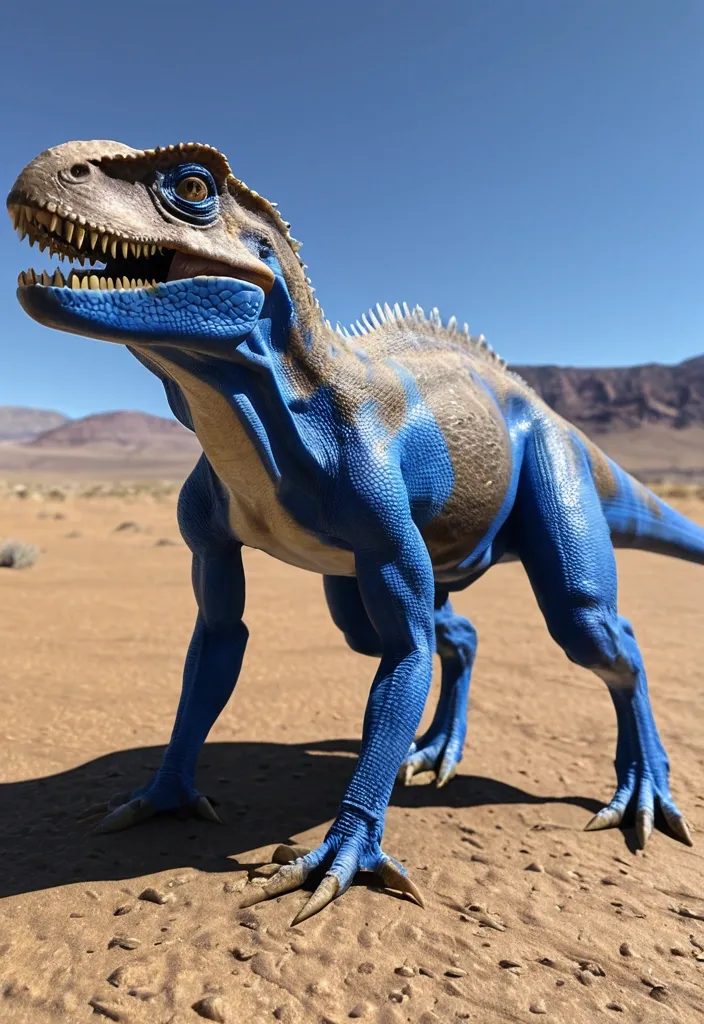
The hybrid was created by modifying the genome of a Tyrannosaurus rex , with the DNA of three other theropod species that were Utahraptor , Saurophaganax , and Giganotosaurus. Also the DNA of Quadrupes like Triceratops , Scelidosaurus , Gigantopithecus. DNA of modern animals such as Greater blue-ringed octopus , Inland Taipan , Northern Short-tailed Shrew , Komodo Dragon , Opossum , Mongoose , Whiptail Lizard , Cuttlefish , and Tardigrades. The genome of Tyrannosaurus rex , Utahraptor , Saurophaganax , and Giganotosaurus was used as the base genome for the hybrid. The shape of the headcrest is from the Triceratops. Utahraptor DNA was added for high levels of intelligence and the ability to make plans , decisions and pack hunting. Gigantopithecus DNA added for Knuckle-walking. Triceratops , and Scelidosaurus armor added a biological form of armor that absorbed most of the incoming attacks. Northern short-tailed shrew iron teeth , the Inland taipan's retractable fangs and the Komodo Dragon serrated teeth genome was used to form the teething of the hybrid. Saurophaganax and Gigantopithecus DNA added the presence of long strong arms with slashing hook claws and the use of tools. Cuttlefish genes were intended to help the hybrid withstand an accelerated growth , but it also added chromatophore cells in the skin so it could change the shape , color , and texture of its skin like a cuttlefish. Opossum , Mongoose and Tardigrades DNA was added for the hybrid to be more resistant to climate changes , harmful toxins or bacterial infections , while tardigrades also added survival of extreme conditions such as exposure to extreme temperatures , extreme pressures , air deprivation , radiation , dehydration , and starvation. Northern short-tailed shrew , the Inland Taipan , Greater blue-ringed octopus and the Komodo Dragon's DNA also added special cavities and glands in the skull that gave her infrared vision , and highly toxic saliva. Said DNA also gave her the ability to open her mandibles and jaws as wide as a snake , specifically at around 90 degrees.Lastly , DNA from a whiptail lizard was added for reproduction purposes. ,
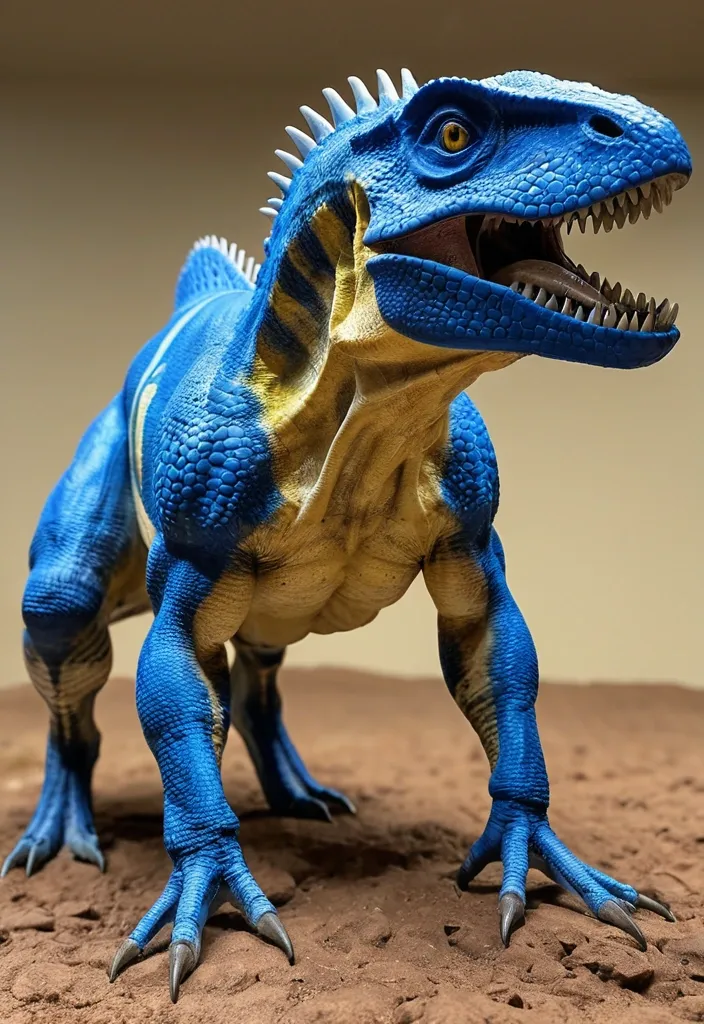
The hybrid was created by modifying the genome of a Tyrannosaurus rex , with the DNA of three other theropod species that were Utahraptor , Saurophaganax , and Giganotosaurus. Also the DNA of Quadrupes like Triceratops , Scelidosaurus , Gigantopithecus. DNA of modern animals such as Greater blue-ringed octopus , Inland Taipan , Northern Short-tailed Shrew , Komodo Dragon , Opossum , Mongoose , Whiptail Lizard , Cuttlefish , and Tardigrades. The genome of Tyrannosaurus rex , Utahraptor , Saurophaganax , and Giganotosaurus was used as the base genome for the hybrid. The shape of the headcrest is from the Triceratops. Utahraptor DNA was added for high levels of intelligence and the ability to make plans , decisions and pack hunting. Gigantopithecus DNA added for Knuckle-walking. Triceratops , and Scelidosaurus armor added a biological form of armor that absorbed most of the incoming attacks. Northern short-tailed shrew iron teeth , the Inland taipan's retractable fangs and the Komodo Dragon serrated teeth genome was used to form the teething of the hybrid. Saurophaganax and Gigantopithecus DNA added the presence of long strong arms with slashing hook claws and the use of tools. Cuttlefish genes were intended to help the hybrid withstand an accelerated growth , but it also added chromatophore cells in the skin so it could change the shape , color , and texture of its skin like a cuttlefish. Opossum , Mongoose and Tardigrades DNA was added for the hybrid to be more resistant to climate changes , harmful toxins or bacterial infections , while tardigrades also added survival of extreme conditions such as exposure to extreme temperatures , extreme pressures , air deprivation , radiation , dehydration , and starvation. Northern short-tailed shrew , the Inland Taipan , Greater blue-ringed octopus and the Komodo Dragon's DNA also added special cavities and glands in the skull that gave her infrared vision , and highly toxic saliva. Said DNA also gave her the ability to open her mandibles and jaws as wide as a snake , specifically at around 90 degrees.Lastly , DNA from a whiptail lizard was added for reproduction purposes. ,
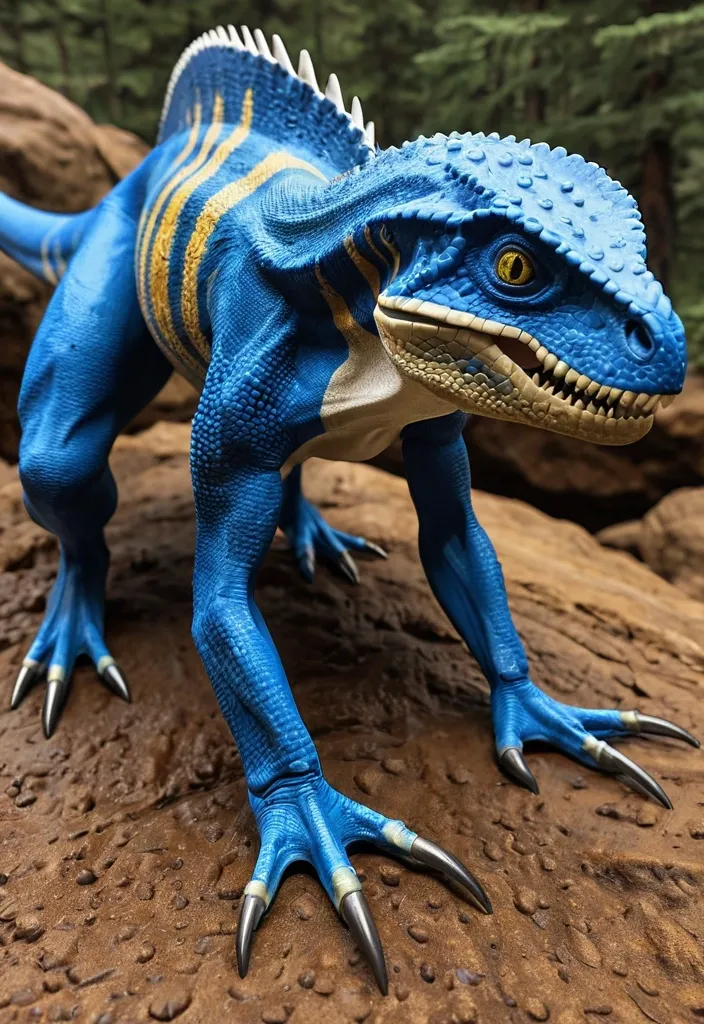
The hybrid was created by modifying the genome of a Tyrannosaurus rex , with the DNA of three other theropod species that were Utahraptor , Saurophaganax , and Giganotosaurus. Also the DNA of Quadrupes like Triceratops , Scelidosaurus , Gigantopithecus. DNA of modern animals such as Greater blue-ringed octopus , Inland Taipan , Northern Short-tailed Shrew , Komodo Dragon , Opossum , Mongoose , Whiptail Lizard , Cuttlefish , and Tardigrades. The genome of Tyrannosaurus rex , Utahraptor , Saurophaganax , and Giganotosaurus was used as the base genome for the hybrid. The shape of the headcrest is from the Triceratops. Utahraptor DNA was added for high levels of intelligence and the ability to make plans , decisions and pack hunting. Gigantopithecus DNA added for Knuckle-walking. Triceratops , and Scelidosaurus armor added a biological form of armor that absorbed most of the incoming attacks. Northern short-tailed shrew iron teeth , the Inland taipan's retractable fangs and the Komodo Dragon serrated teeth genome was used to form the teething of the hybrid. Saurophaganax and Gigantopithecus DNA added the presence of long strong arms with slashing hook claws and the use of tools. Cuttlefish genes were intended to help the hybrid withstand an accelerated growth , but it also added chromatophore cells in the skin so it could change the shape , color , and texture of its skin like a cuttlefish. Opossum , Mongoose and Tardigrades DNA was added for the hybrid to be more resistant to climate changes , harmful toxins or bacterial infections , while tardigrades also added survival of extreme conditions such as exposure to extreme temperatures , extreme pressures , air deprivation , radiation , dehydration , and starvation. Northern short-tailed shrew , the Inland Taipan , Greater blue-ringed octopus and the Komodo Dragon's DNA also added special cavities and glands in the skull that gave her infrared vision , and highly toxic saliva. Said DNA also gave her the ability to open her mandibles and jaws as wide as a snake , specifically at around 90 degrees.Lastly , DNA from a whiptail lizard was added for reproduction purposes. ,

The hybrid was created by modifying the genome of a Tyrannosaurus rex , with the DNA of three other theropod species that were Utahraptor , Saurophaganax , and Giganotosaurus. Also the DNA of Quadrupes like Triceratops , Scelidosaurus , Gigantopithecus. DNA of modern animals such as Greater blue-ringed octopus , Inland Taipan , Northern Short-tailed Shrew , Komodo Dragon , Opossum , Mongoose , Whiptail Lizard , Cuttlefish , and Tardigrades. The genome of Tyrannosaurus rex , Utahraptor , Saurophaganax , and Giganotosaurus was used as the base genome for the hybrid. The shape of the headcrest is from the Triceratops. Utahraptor DNA was added for high levels of intelligence and the ability to make plans , decisions and pack hunting. Gigantopithecus DNA added for Knuckle-walking. Triceratops , and Scelidosaurus armor added a biological form of armor that absorbed most of the incoming attacks. Northern short-tailed shrew iron teeth , the Inland taipan's retractable fangs and the Komodo Dragon serrated teeth genome was used to form the teething of the hybrid. Saurophaganax and Gigantopithecus DNA added the presence of long strong arms with slashing hook claws and the use of tools. Cuttlefish genes were intended to help the hybrid withstand an accelerated growth , but it also added chromatophore cells in the skin so it could change the shape , color , and texture of its skin like a cuttlefish. Opossum , Mongoose and Tardigrades DNA was added for the hybrid to be more resistant to climate changes , harmful toxins or bacterial infections , while tardigrades also added survival of extreme conditions such as exposure to extreme temperatures , extreme pressures , air deprivation , radiation , dehydration , and starvation. Northern short-tailed shrew , the Inland Taipan , Greater blue-ringed octopus and the Komodo Dragon's DNA also added special cavities and glands in the skull that gave her infrared vision , and highly toxic saliva. Said DNA also gave her the ability to open her mandibles and jaws as wide as a snake , specifically at around 90 degrees.Lastly , DNA from a whiptail lizard was added for reproduction purposes. ,

